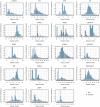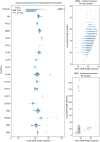Short tandem repeat expansions in sporadic amyotrophic lateral sclerosis and frontotemporal dementia
- PMID: 37146135
- PMCID: PMC10162670
- DOI: 10.1126/sciadv.ade2044
Short tandem repeat expansions in sporadic amyotrophic lateral sclerosis and frontotemporal dementia
Abstract
Pathogenic short tandem repeat (STR) expansions cause over 20 neurodegenerative diseases. To determine the contribution of STRs in sporadic amyotrophic lateral sclerosis (ALS) and frontotemporal dementia (FTD), we used ExpansionHunter, REviewer, and polymerase chain reaction validation to assess 21 neurodegenerative disease-associated STRs in whole-genome sequencing data from 608 patients with sporadic ALS, 68 patients with sporadic FTD, and 4703 matched controls. We also propose a data-derived outlier detection method for defining allele thresholds in rare STRs. Excluding C9orf72 repeat expansions, 17.6% of clinically diagnosed ALS and FTD cases had at least one expanded STR allele reported to be pathogenic or intermediate for another neurodegenerative disease. We identified and validated 162 disease-relevant STR expansions in C9orf72 (ALS/FTD), ATXN1 [spinal cerebellar ataxia type 1 (SCA1)], ATXN2 (SCA2), ATXN8 (SCA8), TBP (SCA17), HTT (Huntington's disease), DMPK [myotonic dystrophy type 1 (DM1)], CNBP (DM2), and FMR1 (fragile-X disorders). Our findings suggest clinical and pathological pleiotropy of neurodegenerative disease genes and highlight their importance in ALS and FTD.
Figures





References
MeSH terms
Substances
Supplementary concepts
LinkOut - more resources
Full Text Sources
Medical
Research Materials
Miscellaneous

